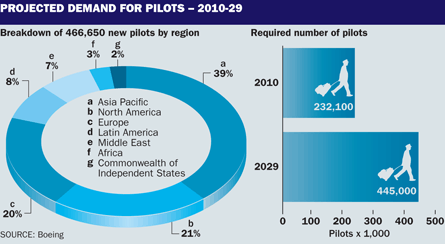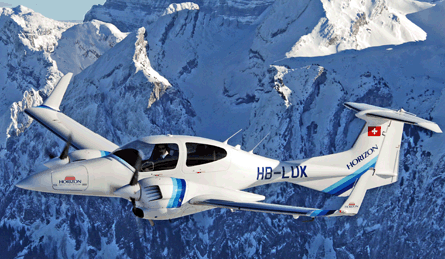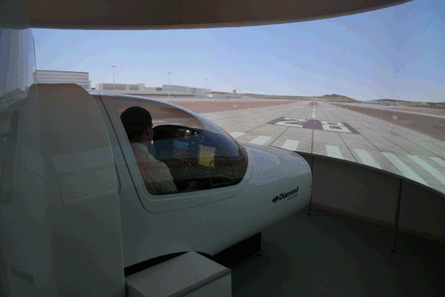Pilot demand may be forecast to surge over coming years, but flight academies are struggling to fill places - mainly because of a lack of funding for aspirants to a career as flightcrew members.
Working as a pilot has long been a dream job for many young people. The glamour and generous layover times at exotic locations associated with the airline industry's glory years, from the 1950s to the 1980s, have mostly gone, but a seat in an aircraft's "front office" still involves a wide range of demanding and satisfying disciplines.
 |
|---|
© Horizon Swiss Flight Academy |
Pilots must master a complex, dynamic environment that differs greatly from the desktop work that now typifies many other professions. They handle sophisticated technology, physics, navigation, meteorology and flight planning, and deal with people in the air and on the ground all around the globe, all the while being infused with the sheer sensation of flying. But the cost of training has traditionally been a central concern of aspiring flying cadets. Ab initio programmes for applicants with no flying experience, which lead to the air transport pilot's licence (ATPL), can typically cost around £65,000 ($100,000). On top of that come the cost of living, any additional expenses and, if the applicant already has another career, loss of income during the training period. A full-time course typically lasts between 18 and 24 months.
Silvio Dreier, head of training at Horizon Swiss Flight Academy in Zurich, acknowledges that financing is a hurdle, but argues that it is rarely the single problem that prevents an aspirant from starting flight training. "It's not the case that only children from wealthy families can become pilots," he says. "This is often being said, but not true in our experience. There are almost always good, workable solutions possible."
Nearly all of Horizon's trainees pursue modular part-time programmes while working in other jobs to allow them to sustain their daily living costs and afford the required flight hours and ground schooling. Students are generally between 25 and 35 years old, and come to fulfil their pilot ambitions after having established a first career elsewhere.
This is a typical path into the cockpit for young Europeans who have not been selected for airline-sponsored pilot-training schemes, which are available to a limited number of applicants either in company-owned or - affiliated flight academies.
PART-TIME TRAINING
While part-time training obviously takes longer - an ab initio ATPL programme takes typically around 30 months - graduates are more likely to complete their licences with less debt than their full-time peers. Not only is this a psychological advantage when applying for the first cockpit job, but the income eases the pressure created by the mandatory minimum flight hours necessary to maintain the pilot licence in the meantime. Students at Horizon can enjoy another confidence boost if they succeed in employment pre-screening by parent company Helvetic Airways. The charter carrier issues a letter of intent to trainees, promising preferential consideration in the application process if the airline recruits pilots.
For full-time trainees, however, costs have become the main obstacle. "The self-funded student has gone away, basically because there are no financial means available to them," says Dan Greenhill, centre manager of the FlightSafety Academy in Vero Beach, Florida.
 |
|---|
The proportion of self-funded students at the school has dropped from around two-thirds before mid-2008 to 10% today. The main business now is flight training for airlines, especially from Asia and Europe. Their programmes vary in volume and content depending on what part of the syllabus the airlines have contracted to FlightSafety. The number of students at the campus averaged 275 last year.
Because of the financial crisis and subsequent recession, US banks have stopped providing student loans to private individuals seeking to start flight training. Similarly, support organisations for children from financially poor backgrounds, such as the non-profit Education Resources Institute, have stopped trading. Another way to raise funding was by remortgaging the family home, but this option has also evaporated with the collapse in the US housing market.
Greenhill reports that the academy has a waiting list with several hundred applicants, who want to begin training but have no access to funds. "I have looked for a variety of sources for revenue but have not been able to come up with anything," he says.
ASIA PACIFIC TO LEAD PILOT DEMAND: BOEING Boeing's Current Market Outlook of 2010 predicts that the commercial aviation industry will require an additional 466,650 pilots over the next 20 years (see chart), to support fleet growth and retirements. The total number of pilots required will rise from 232,100 in 2010 to 445,000 in 2029, the airframer says. Factoring in retirements and workforce attrition, that translates to a need for 466,650 new pilots - an average of 23,300 a year - with Asia Pacific being the most demanding region. Over the 20-year period it requires 180,600 pilots, of whom China accounts for 70,600. North America will need 97,350, Europe 94,800, Latin America 37,000, the Middle East 32,700, Africa 13,200 and the CIS 11,000. Boeing's analysis identifies a need for 30,900 new aircraft within the same period. Again, Asia Pacific leads the way, with a requirement for 10,320 new aircraft, while North America is expected to induct 7,200, Europe 7,190, the Middle East 2,340, Latin America 2,180, the CIS 960 and Africa 710. |
Yet the aircraft manufacturers' bulging orderbooks are only part of the story. Another reason for the growing need for flightcrew is pilot retirement.
In anticipation of a flightcrew shortage, the Federal Aviation Administration elected in 2007 to raise the retirement age from 60 to 65. However, unless a new generation is trained, the measure will only delay, not avert, the impact. Of the 60,000 pilots in the USA today, around 37,000 - nearly two-thirds - are due to retire between 2012 and 2017, says Greenhill. He expects that when the US economy picks up, the airlines will hire all available graduates, instructors and furloughed pilots, but then fall short. "There is definitely going to be a gap in pilot supply, because there has been nobody in the training pipeline here over the past two-and-a-half years."
The problem has been aggravated by the collapse in the business aviation market, which has traditionally offered an early career step, especially to young US pilots who have completed flight training and hour-building as instructors. Here lies the central difference in the pilot-supply dynamics on either side of the Atlantic: while European flight school graduates aim for airline jobs straight after gaining their licences, pilot recruitment in North American airlines is based more on seniority and flight time.
MARKET COLLAPSE
Fresh commercial pilot licence (CPL) holders in North America usually move on to earn an instructor rating and then build flight hours and experience by teaching new cadets how to fly. The next step thereafter is often a job in the right-hand seat of a business or regional aircraft.
A factor in the decline of executive aviation market has been regulatory changes regarding pilot qualification for Part 121 operators, which include commercial air carriers. First officers need only a CPL with a minimum flight time of 250h, but last year the US Senate passed legislation stipulating that all pilots must in future have an ATPL, which requires 1,500h. This review was sparked by the Colgan Air Bombardier Q400 accident on approach to Buffalo, New York, in February 2009. The rule will delay the availability of young pilots on the job market.
 |
|---|
© Horizon Swiss Aviation Academy |
The coming retirement wave inflates the demand for flightcrew beyond that created by the need for additional pilots for the extra aircraft resident in the manufacturers' orderbooks. "If there are no pilots for the airlines to grow, what happens to Airbus and Boeing?" wonders Greenhill. "It's a huge domino effect that is going to affect the industry."
To overcome the stagnation, airlines will have to sponsor cadets and invest in their own pilot schools, argues Greenhill. "I just look at the airlines that are growing abroad and how they are getting their pilots. We have to change some aspects here [in the USA] of how we train pilots. If the self-funded person is not able to get financing, someone is going to have to. And if the [airline] business wants to grow, they have to figure out a way and look a little bit at the Lufthansa model. They sponsor them, train them to their standards and then have a pool of pilots."
The German carrier has traditionally paid for the training of its junior flightcrew at its own pilot school up front, but deducts a portion of the cost from the salary through monthly instalments, after the employee starts working. "We have always had this mentality in the US that 'I steal some pilots from you and you steal some from me'," says Greenhill. "But that's not going to happen if there isn't anybody to steal."
Dreier's bugbear is not lack of finance but a lack of perseverance among cadets. Many students have failed because they did not have the determination and strength to complete the two-and-a-half-year training programme, so the main problem is finding applicants with the ability to stick it out, work hard, demonstrate discipline and perform under stress over a long period, he reports.
 |
|---|
© Horizon Swiss Aviation Academy |
Two years ago, Horizon Swiss Flight Academy introduced a mandatory aptitude test for all applicants in a bid to minimise drop-outs. Apart from testing knowledge in school subjects such as physics, mathematics and English, the assessment includes psychometric tests such as stress resistance, ability to set priorities, and motivation to perform. The aim is to determine whether the applicant has the mental capability to complete the training and perform reliably in the cockpit later on.
BUILDING A REPUTATION
The benefit for the school lies in building a reputation as an organisation from which graduates stand a good chance of finding work later on. The objective is that 85% of trainees secure a position in a multi-crew environment within 12 months of graduation, says Dreier. "We depend on the image that our students find a job. You can do as much advertising as you want, [but] if you don't achieve that, you can close the school down," he says.
It is important to uphold the selection process even in difficult economic times, when the student numbers go down, he explains. "Otherwise, the tab has to picked up later on as a boomerang effect."
For full-time cadets in integrated programmes, financing flight training remains the main challenge, despite a promising outlook for the pilot job market. FlightSafety's Greenhill advises aspirants not to wait, if funding is available. "The wave is coming and you want to catch it as it arrives."
Source: Flight International



















